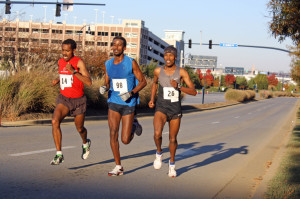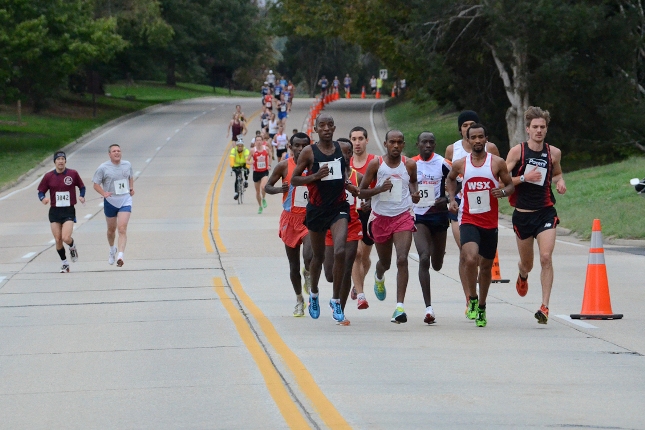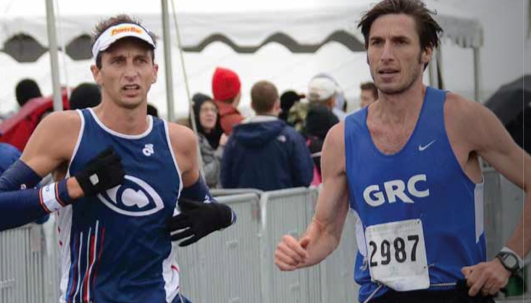
The history of the Woodrow Wilson Bridge Half Marathon is short but impressive.
Four years ago, in its debut year, the women’s race was won by Catherine Ndereba, better known as “Catherine the Great.” In its second year, a new course record was set (1:02:37) and four American men notched qualifiers for the U.S. Olympic Marathon Trials.
The prize purse includes $1,200 for the male and female winners and $600 for top Americans. The race also hosts the Road Runners Club of America National Half Marathon Championships, the Potomac Valley Association USATF Championship and the National Industries for the Blind Visually Impaired National Half Marathon Championships. And with a fun yet challenging course that starts with eight miles on the George Washington Memorial Parkway, climbs over the Woodrow Wilson Bridge, and finishes with a big loop around National Harbor, the race draws more than 3,000 runners of all abilities.
Oh, but those eight opening miles on GW Parkway, a national park …
On day two of the federal government shutdown – four days before the Woodrow Wilson Bridge Half Marathon – Race Director Steve Nearman was forced into making a tough decision.
Due to the shutdown, the race was postponed until November 10, more than a month after the original date. Deferrals to next year’s race were offered and about 600 were processed, Nearman said, while 1,739 runners came out to race on the new date.
Meanwhile, Nov. 10 was as good as Oct. 6 for Kellyn Johnson. The 27-year-old professional runner claimed her second straight win in 1:13:02 and earned prize money in both the overall and American-only divisions.
“It just gave me a little more time to train,” she said. “It was something that was on my schedule before and then it happened to fit perfectly into it after.”
Johnson trains in Flagstaff, Ariz., with Team USA Arizona and said she is still experimenting with distances between 5K and the half marathon. She ran the 5,000- and 10,000-meter races at the 2012 U.S. Olympic Track and Field Trials, and was 4th in this year’s national 10-mile championship hosted by the Cherry Blossom 10 Mile Run. She will return to the area Nov. 17 for the .US National Road Racing 12K Championships.
Johnson was followed by Desta Tadesse of Ethiopia (1:13:53). Waynishet Abebe, an Ethiopian runner who lives in D.C., was 3rd in a personal best time of 1:14:10, just a few weeks after winning the Atlantic City Marathon.
Lindsay O’Brien of Washington, D.C., in her second half marathon, finished 7th overall and was 2nd American. Her time, 1:18:54, was more than a minute faster than her last attempt at the distance.
O’Brien was a three-time cross country All-American at Yale who took a break from competitive running and now trains with Georgetown Running Club.
“I’m trying not to be daunted by the distance,” she said. “This was a good step in the right direction.”
The men’s race was led by a pack of three: Girma Gebre, Siraw Kebede, and Nahom Mesfin, all from Ethiopia.
They raced side by side, charging together up a tough hill in National Harbor. But at the 12-mile mark, Gebre made a strong move to win decisively in 1:04:40.
Gebre has been living in New York with his manager, Alem Kahsay, who said Gebre’s background is in the middle distances. Mesfin, though, is no slouch in the leg speed department, either: He has competed in two Olympics in the steeplechase, and said he spent most of the past nine months training at altitude in Flagstaff, Ariz. Mesfin, however, admitted that Gebre’s move was simply too strong to match.
“Anyway, I’m happy,” he said, smiling after his third-place finish.
The men’s chase pack of four included Georgetown Running Club’s Kieran O’Connor.
O’Connor, 26, has only been running competitively for a few years. But he has already won a marathon and was the 8th American in Boston in 2012. After earning a master’s degree at a university in Cairo, Egypt, O’Connor recently moved to D.C., joined Georgetown Running Club, and – for the first time – started doing speed work under the eye of coach Jerry Alexander.
Going into today’s race, O’Connor’s half marathon best was in the 1:09s. He took it out easy, he said, on the opening downhill from the start in Mount Vernon; men and women were flying ahead of him. But then they started coming back – 5:05 miles clicking away.
At the top of the hill in National Harbor, O’Connor knew his goal of breaking 1:07 was within his reach. And rather than be intimidated by the professional runners surrounding him, O’Conner dropped them on the way to running 1:06:49 – good for 4th overall and top American.
In the visually impaired national championships, Aaron Scheidies, like Johnson, appreciated having extra time to train.
Scheidies won the men’s division last year in 1:18:05. This year, in the week’s before the original race date, Schiedies finished 2nd in the visually impaired division of the triathlon at the London Paralympics. Afterward he took a vacation.
Guided by Georgetown Running Club’s Dave Wertz, Schiedies won his second straight national championship and claimed a new personal best and event record of 1:16:24.
“I didn’t expect it, so I’m really happy with the time,” he said.
Adjusting to a New Race
The Wilson Bridge Half Marathon was supposed to be Briana Whelan‘s tune-up race for the Marine Corps Marathon, her first attempt at 26.2 miles.
When it was postponed, Whelan did not find a replacement race. She nonetheless had a great experience in her first marathon, which she ran with her cousin and uncle.
As for this morning, the Washington, D.C., resident and running newbie ended a two-week break to finish her third half marathon of 2013.
Chris Beeler, a U.S. Army colonel on a year-long assignment in the District, has been training with DC Road Runners and planned to use the Wilson Bridge Half Marathon as a confidence booster for the Army Ten Miler, held on October 20. Her goal race complete, it was hard to stay motivated to run another race, she said.
“But in the end,” she said, “it is what it is, and it was a beautiful day today.”
Miguel Gonzales of Manassas, Va., said the shutdown and the postponement it forced derailed his training. In the 1990s, he ran professionally, but with a busy job and four daughters between 2 and 9, Gonzales – until about a year ago – had more or less stopped running altogether.
“I got to 200 pounds and said I need to lose some weight,” he said. And while today was tough for him and he “felt horrible,” Gonzales said he thought of today’s race as a fresh start.
Mark Geiger of Waldorf, Md., finished his first half marathon, culminating several months of training. He said he could not remember the exact reasons he started running about a year ago – only that he started with walking and, week by week, added a little more running.
“I think it worked out better because the weather today was better,” said Geiger, referring to the rescheduled date.
The weather this morning was perfect for racing. October 6 in Washington, D.C., on the other hand, was a hot day. And let me tell you: This runner has woken up on many such race days and thought to himself: Man, if there’s any way this race could be postponed …

The federal government shutdown had been light on runners for two days, but Wednesday night saw a flurry of decisions that impacted weekend racing schedules, with the postponement of the Woodrow Wilson Bridge Half Marathon and the Run! Geek! Run! 8k. The Ragnar Relay will see a few legs altered, but the Army Ten-Miler and Marine Corps Marathon late this month claim they will not be affected, according to race officials who have not provided any details.
Though runners have largely had their run of National Park Service land since Tuesday morning, with vehicle traffic closed on Rock Creek Park’s Beach Drive and most of East Potomac Park’s Hains Point. The problem, however, is the provision in the shutdown the rescinds special events permits, necessary for holding races.
Wilson Bridge Half Race Director Steve Nearman made the call to postpone the race until Nov. 10 Wednesday night. More than eight miles of the course follows the George Washington Memorial Parkway, a National Park.
“The race crew had been working all along as though we were having the race as planned, but I started looking at alternatives,” he said. “I looked at every Sunday and found one that wouldn’t have a Redskins game or a conflicting event. We pretty much had one opportunity between now and Christmas.”
Nearman knew before Labor Day that his race was in jeopardy of being affected by a potential government shutdown.
“It was a short month for Congress to get its resolution together and the Syria situation took attention from that,” he said. “Sunday, I knew this wasn’t going to end well, but you have to live in hope things can be worked out.
“I had to balance giving talks a chance, because I didn’t want to make a decision too early and wind up being able to hold the race. If there’s anything I’ve learned from friends in the business who dealt with the New York and Boston marathons this year, you don’t want to wait too long, so I decided tonight (Wednesday) that we’d give people a little time to change their weekend plans.
Postponing the race meant many runners will now be scrambling to find a pre-Marine Corps Marathon tuneup race. Marine Corps, and the Army Ten-Miler, are on track to be held.
Amanda Spoden of Virginia was undeterred by the postponement. “My plan is to keep training for the Nov. 10 race and make the most of the situation,” she said. “I’m viewing it as five more weeks to increase my PR.”
“The hardest part has been managing expectations,” Nearman said. “A lot of people don’t realize the race was on park service land, they thought it was Alexandria roads, so there was an education component to our communications, but we’ve tried to stay proactive on Facebook because our fans and runners are loyal but want information.”
Spoden appreciated that, and said the race committee’s openness about the situation has motivated her more.
Run!Geek!Run!, an 8k starting in West Potomac Park and heading into East Potomac Park Saturday morning, is tentatively scheduled to be run Nov. 16. Saturday’s Heel-to-Heel 5k, scheduled for the C&O Canal Towpath in Washington has been postponed to an undetermined date, and the Take a Sick Day and Run a 5k scheduled for Friday on the Capital Crescent Trail in Georgetown has been cancelled.
The Ragnar Relay, running 200 miles between Cumberland, Md. and the National Harbor, will still go off Friday morning as planned, but the three legs of the race that run along the C&O Canal Towpath in Maryland will be skipped, and part of one leg will be rerouted.
Race Director Milo Willaims said the runners assigned to the three legs that will be skipped will likely make up the distance by running other legs, concurrently with their teammates.
The federal budget morass had already impacted the Wilson Bridge Half, with sequestration-forced budget cuts reducing the grant from the National Industries for the Blind to bring runners to the race, which serves as the NIB half marathon championship.
The shutdown will also affect the DC Running Club’s Take a Sick Day and Run a 5k Friday on the Capital Crescent Trail.
Several area races are scheduled for the following weekend on NPS land. Boo! Run for Life 10k Race Director Brian O’Neill is hopeful that the situation does not impact the next weekend’s races, citing the possibility of a continuing resolution that funds the National Parks Service. One such resolution was tabled in the House.
“Even if such a resolution is not passed, an alternative determination could be made,” he wrote.
Other races next weekend on NPS land include:
- Oct 12: Stokes School 5k – West Potomac Park
- Oct 12: Mount Vernon Trail Race 5 – Fort Hunt Park
- Oct 13: Monster Mask 5k – C&O Canal Towpath

(The Woodrow Wilson Bridge Half Marathon will once again serve as the Visually Impaired Half Marathon Championships)
I don’t know how I want to write this.
I could write that Aaron Scheidies is the best visually-impaired triathlete in the world.
I could write that Aaron Scheidies is a world class triathlete who is visually impaired.
Both sentences, I suppose, are true. And if you go to Aaron’s website, as I did after I agreed to serve as his guide at the recent Woodrow Wilson Bridge Half Marathon, you can go to the “news” section and find many such articles filled with those kind of sentences. Aaron is an amazing athlete. He is as dedicated to his sport as anyone you will ever meet.
But I think, after a weekend spent getting to know this 30-year-old athlete from Seattle, I think what I want to write the most is that Aaron, who in his childhood suffered from macular degeneration, in no way views his blindness as a disadvantage.
To compete at his highest level, all Aaron needs is a guide – someone to watch his path, someone to tell him when to turn, someone to advise him on the tangents, someone to let him know where the water stops and mile markers are and what the clock reads.
Aaron’s guide is not a pacer.
Aaron’s guide, for the most part, is a set of eyes.
Perhaps a month before the race, Jerry Alexander, the coach of Georgetown Running Club, which I belong to, sent out an email encouraging members to serve as guides for participants in the event’s National Industries for the Blind’s championship for the visually impaired. Our club provided guides last year, and many of us again signed on this year.
And to be honest, I can’t remember the exact reason I offered to do it. It was more of an impulse.
But get this:
On Friday, Oct. 5, Aaron, traveling alone, landed at Reagan National Airport on a red-eye flight.
He took the Metro to the Eastern Market stop in Capitol Hill. From there, he planned to walk to the Starbucks on Pennsylvania Avenue, where he would hang out until his host was able to meet up. Our plan, which we had established through email, was to meet up after I got off from work and practice running together.
That morning, I took my dog to the nearest dog park. And as I looked up from unhooking my dog’s leash to let him roam, someone I recognized was walking toward me.
He asked me how to get to Starbucks. As it turns out, he was a just a block or two off course.
“Aaron,” I said. “You’re not going to believe this. I’m Dickson.”
We were flying down the opening downhill from Mount Vernon, a bungee cord wrapped around our waists. He had told me he liked downhills. He would probably get out a little fast, he said, then settle into a pace that felt right.
His personal best in the half marathon heading into the Woodrow Wilson Bridge Half Marathon was 1:20, and from the start he was easily on pace to shatter it.
I ran off his left shoulder.
Fairly quickly, the field spread out across the wide George Washington Memorial Parkway. At times, we ran with someone; more often we were alone, zig-zagging across the road to hit the tangents, for which my guide were in fact the runners ahead of us.
Move a little to the left, I’d say. A little more.
It was cool and rainy; we were both glad we had gone with gloves.
We would lose a little bit of time on the water stops: I would have to swing behind him to his right to grab the cups, and I don’t think I ever quite got it down.
Other than that, things went pretty smoothly. Even better, Aaron was running steady, clocking 5:45s on the more downhill miles and closer to 6:00 on the hillier ones.
The bridge is where this race gets serious. It’s a long climb to the top, the concrete pounding your legs. Then it’s a long downhill, followed by – for Aaron, anyway – a lot of me saying, “Left, right, left, right,” as we snaked back to the final couple miles in National Harbor.
He went through 10 miles in 59:17, and when we hit that big hill in National Harbor, I could tell he was really working – he was there.
He passed Mile 12 in 1:11:30.
“We can break 1:18,” he said, as we hit that off-road stretch sighted runners like to complain about. There were, truthfully, some big rocks in that path, some bumps, some super-tight turns.
I could not really be much help.
“It’s not a big deal,” he said, as he exited the path and made his final half-mile charge towards the finish line in National Harbor.
Those last couple minutes, for some reason, I thought hard about these 13 years – this journey that has taken me all the way from my teens to my 30s, and how ineffably grateful I was to be along for this particular ride.
There are the good races, more bad races. There are the highs, the lows.
But the journey, and the runners, will always be worth it. Aaron crossed the line in 1:18:05. He bent over, spent. I patted him on the back. And having already memorized this particular course, he then guided me to our bags.
Visit www.runwashington.com to hear a podcast about the visually impaired runners who competed at the VI Half Marathon Championships.

